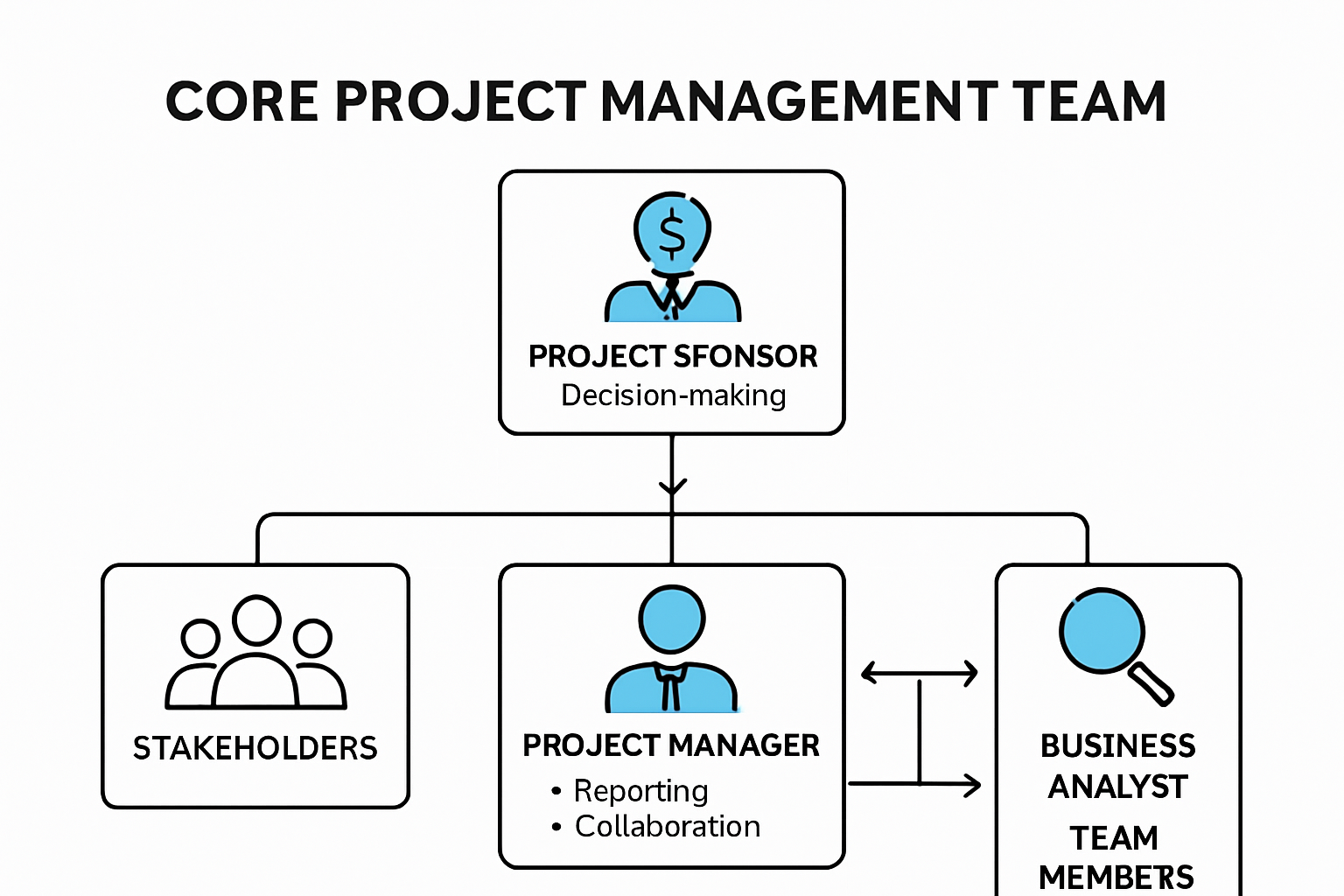Project management might sound all about calendars and checklists, but the truth is much deeper. Many leaders miss that clear role definition can improve project outcomes by up to 40 percent. Surprisingly, it is not the biggest budgets or the best technology that lead projects to success. The most unexpected driver is how precisely each team member’s role is defined and understood—and that is where real results begin.
Table of Contents
- Understanding Key Roles In Project Management
- Core Responsibilities For Each Project Role
- How To Assign And Manage Project Roles Effectively
Quick Summary
| Takeaway | Explanation |
|---|---|
| Clearly define project roles | Clear role definitions ensure responsibilities are understood and contribute to project success. |
| Foster effective communication | Open channels promote collaboration and problem-solving among team members, enhancing project dynamics. |
| Align roles with skills | Matching individual strengths with role requirements supports efficiency and maximizes team potential. |
| Implement ongoing performance management | Regular performance reviews and feedback help address issues early and keep projects on track. |
| Encourage team development and growth | Continuous learning and adaptability foster a resilient team ready to tackle evolving project needs. |
Understanding Key Roles in Project Management
Project management is a complex ecosystem where success hinges on clearly defined roles and responsibilities. Understanding these roles is crucial for leaders who want to drive effective project outcomes and maintain organizational efficiency.
The Core Project Management Team Structure
At the heart of every successful project lies a well-structured team with distinct responsibilities. Research from Weill Cornell Medicine highlights the critical roles that form the backbone of project management. These roles are not just job titles but strategic positions that ensure comprehensive project oversight and execution.
To help leaders understand who plays which part in project management, here is a summary table outlining key project roles and their primary responsibilities. This provides a quick reference for the major players and what they contribute to project success.
| Project Role | Primary Responsibilities |
|---|---|
| Project Sponsor | Provides strategic direction, secures resources, approves major decisions, and ensures organizational alignment |
| Project Manager | Manages day-to-day operations, coordinates tasks, monitors progress, manages budgets, ensures quality |
| Business Analyst | Bridges business and technical requirements, analyzes needs, documents specifications |
| Project Team Member | Executes technical/functional tasks, collaborates with team, meets milestones and quality standards |
| Stakeholder | Provides input and feedback, validates project outcomes, ensures alignment with organizational goals |

The project management team typically consists of several key players. The Project Sponsor provides strategic direction and secures necessary resources. They are the executive-level champion who approves major decisions and ensures alignment with organizational goals. The Project Manager serves as the central orchestrator, responsible for day-to-day management, coordination, and ultimately delivering the project within specified constraints of time, budget, and quality.
Critical Responsibilities and Interactions
According to Purdue University’s Project Management research, project managers have multifaceted responsibilities that extend far beyond simple task tracking. These include developing comprehensive project scopes, creating and leading project teams, monitoring progress, managing budgets, ensuring stakeholder satisfaction, and evaluating overall project performance.
The Business Analyst plays a pivotal role in bridging technical requirements with business objectives. They analyze project needs, document requirements, and help translate complex technical specifications into actionable plans. Stakeholders provide critical input, perspectives, and validate project outcomes, representing various organizational interests and ensuring the project meets broader strategic objectives.
Collaborative Dynamics and Team Integration
Successful project management is not about individual roles but how these roles interact and collaborate. Each team member brings unique skills and perspectives that contribute to the project’s success. Communication channels must remain open and transparent, with clearly defined expectations and accountability mechanisms.
Team members must understand not just their individual responsibilities but how their work connects with and impacts others. This interconnectedness requires mutual respect, clear communication protocols, and a shared commitment to project goals. Effective project teams embrace flexibility, continuous learning, and proactive problem-solving.
Leaders who invest time in clarifying roles, establishing clear communication frameworks, and fostering a collaborative environment set the stage for remarkable project achievements. By recognizing that each role is essential and interconnected, organizations can transform complex projects into successful, well-executed initiatives.
Learn more about optimizing team collaboration and discover strategies that can elevate your project management approach.
Core Responsibilities for Each Project Role
Successful project management relies on each team member understanding and executing their specific responsibilities with precision and commitment. According to the National Institutes of Health, creating and maintaining an environment that guides a project to successful completion requires clear role definition and strategic accountability.
Strategic Leadership and Decision Making
At the top of the project hierarchy, the Project Sponsor bears critical strategic responsibilities. Research from Weill Cornell Medicine reveals that sponsors are responsible for providing high-level organizational vision, securing financial resources, and making pivotal decisions that align the project with broader business objectives. They serve as executive champions who validate project direction and ensure substantial organizational support.
The Project Manager operates as the central orchestrator, translating strategic vision into actionable plans. Purdue University’s Project Management research highlights their multifaceted responsibilities: developing comprehensive project scopes, creating robust team structures, monitoring progress against established timelines, managing complex budgets, and maintaining consistent stakeholder satisfaction.
Technical and Analytical Responsibilities
Business Analysts play a nuanced role in bridging technical complexity with strategic business needs. Their core responsibilities include conducting detailed requirement analyses, documenting intricate project specifications, and translating technical language into comprehensible strategic insights. They serve as critical interpreters who ensure that technological solutions directly address business challenges.
Project team members have equally important responsibilities centered around executing specific technical or functional tasks. These professionals must demonstrate exceptional skills in their designated areas while maintaining collaborative communication. Their work requires precision, adaptability, and a commitment to meeting project milestones and quality standards.
Communication and Collaboration Imperatives
Stakeholders represent diverse organizational interests and carry the responsibility of providing strategic input, validating project outcomes, and ensuring alignment with broader organizational goals. Their engagement is crucial for maintaining project relevance and securing ongoing support.
Effective communication emerges as a universal responsibility transcending individual roles. Team members must cultivate transparent, consistent communication channels that facilitate information exchange, problem resolution, and collective accountability. This requires active listening, clear articulation of ideas, and a commitment to collaborative problem solving.
Leaders who understand these intricate role responsibilities can create high-performing project ecosystems. By establishing clear expectations, fostering mutual respect, and promoting continuous learning, organizations can transform complex projects into streamlined, successful initiatives.
Explore advanced team collaboration techniques to elevate your project management approach and unlock team potential.
How to Assign and Manage Project Roles Effectively
Effective role assignment and management are critical foundations for project success. Research from the University of Massachusetts Boston emphasizes that a well-defined formal structure ensures each team member understands their specific authority and responsibilities.
Assigning and managing project roles effectively is a multi-step process. The following table summarizes the key steps, their descriptions, and the intended outcome to provide a clear process for leaders aiming to optimize team structure.
| Step | What It Involves | Intended Outcome |
|---|---|---|
| Skill Assessment | Evaluate team members’ technical and soft skills | Match individuals with suitable project roles |
| Role Assignment | Align strengths and collaboration potential | Effective and cohesive team structure |
| Performance Management | Set clear expectations, regular check-ins, feedback | Early issue detection and project alignment |
| Continuous Development | Assess skills periodically and enable cross-training | Ongoing role optimization and team growth |
Strategic Role Alignment
Successful role assignment begins with a comprehensive understanding of project requirements and individual team member capabilities. Leaders must conduct thorough skill assessments that go beyond technical competencies, evaluating soft skills, communication abilities, and potential for collaboration. According to the Project Management Institute, an effective project manager serves as the critical connector who defines roles and responsibilities with precision.
The process of role assignment requires careful consideration of several key factors:
- Skills Matching: Align individual strengths with specific project requirements
- Potential for Growth: Identify opportunities for professional development
- Team Dynamics: Consider interpersonal relationships and collaborative potential
Performance Management and Accountability
Once roles are assigned, establishing clear performance expectations becomes paramount. The National Institutes of Health highlights the importance of proactive leadership in project management, which includes providing clear guidance, evaluating performance, and ensuring timely resolution of challenges.
Effective performance management involves:
- Regular check-ins and progress reviews
- Transparent communication channels
- Constructive feedback mechanisms
- Flexibility to adjust roles as project dynamics evolve
Continuous Development and Role Optimization
Project role management is not a static process but a dynamic, ongoing strategy. Leaders must remain adaptable, recognizing that team members grow, skills develop, and project needs change. This requires a commitment to continuous learning and role refinement.

Key strategies for ongoing role management include:
- Periodic skill assessment
- Cross-training opportunities
- Creating flexible role boundaries
- Encouraging knowledge sharing
Successful leaders understand that effective role management goes beyond initial assignment. It requires ongoing attention, support, and a commitment to team development. By creating an environment of clear expectations, mutual respect, and continuous growth, organizations can unlock their team’s full potential.
Discover advanced team management techniques to transform your project management approach and drive exceptional results.
Frequently Asked Questions
What are the key roles in project management?
The key roles in project management include the Project Sponsor, Project Manager, Business Analyst, Project Team Members, and Stakeholders. Each plays a specific part in ensuring project success through clear responsibilities.
How can clear role definitions improve project outcomes?
Clear role definitions can improve project outcomes by up to 40 percent by ensuring that each team member understands their responsibilities and how they contribute to the project’s objectives.
What is the importance of communication in project management?
Effective communication is essential in project management as it facilitates collaboration, problem-solving, and ensures that team members are aligned with project goals and expectations.
How can leaders manage and assign project roles effectively?
Leaders can manage and assign project roles effectively by conducting skill assessments, aligning individual strengths with role requirements, setting clear performance expectations, and fostering continuous development opportunities.
Transform Project Roles Into Real Results With Gammatica
Struggling to keep project roles clear and team responsibilities on track? The article highlighted how role confusion can drain efficiency and hold your projects back. Vague deliverables and mismanaged team assignments not only cause frustration but can also jeopardize your final outcomes. Gammatica recognizes the pain points of undefined roles, scattered task assignments, and the overwhelming burden of manual coordination discussed in this guide. Our platform uses AI-driven workflows, role-based permissions, and intuitive tools to make sure your project structure stays strong and your team always knows what to do next.

Stop letting unclear roles slow your business down. See how Gammatica helps you match every team member to the right task using customizable job templates, Kanban boards, and automated checklists. You gain clear project oversight, boost communication, and control access for streamlined collaboration. Now is your chance to turn the clear role definitions from this article into measurable project wins. Visit Gammatica’s homepage and experience first-hand how easy it is to assign, manage, and optimize every role on your team.
Recommended
- Project Progress Tracking: Strategies for Success in 2025 | Gammatica
- How to Manage Tasks Effectively in 2025: Proven Strategies for Leaders | Gammatica
- Lead Management for Beginners: 2025 Guide for Teams and Leaders | Gammatica
- Collaborative Decision Making for Leaders: Strategies for 2025 | Gammatica



